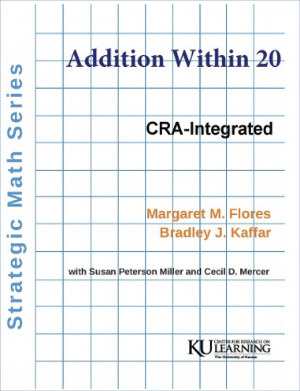Strategic Math: Addition Within 20

This strategy is for students who may have memorized some addition facts, but are not fluent in addition facts with sums between 10 and 20, do not show an understanding of addition and its relation to subtraction, or have enough number knowledge or flexibility to solve unknown addition problems.
Authors: Margaret M. Flores, Bradley J. Kaffar
Publication and Purchasing Information: University of Kansas, Center for Research on Learning / KU CRL Online Store
Research:
Students who later benefited from this program made the following errors: (a) completed addition problems with sums of one less than the actual answer (7 + 6 = 12), (b) left answers blank, or (c) wrote one of the addends as the sum (5 + 8 = 8).
The purpose of this program is to build students’ understanding of addition and sense of numbers (e.g., number magnitude, place value). In addition, the program is about understanding the operation in the context of real-life situations; thus, each lesson includes word problems. As lessons proceed, students solve word problems and differentiate between addition and subtraction. This allows students to engage in mathematical practices.
The first author conducted field tests of Addition Within 20 lessons with elementary students who participated in tier two and tier three instruction within multi-tiered systems of support (MTSS). During the first field test, three students who had completed first grade completed the program and showed significant progress Hinton, 2018). The second field study included five second-grade students (Flores & Hinton, under review). Within a multiple-probe across students design, a second grade teacher used Addition Within 20 to teach three groups of students receiving tier two instruction. The students improved their knowledge of numbers and addition by increasing their performance from 6%-67% to scores of 100% after the intervention. Hinton and Flores (under preparation) conducted a study in which two second grade classrooms participated. One teacher used Addition Within 20 and the other teacher used the general education curriculum. The researchers assessed students’ growth in conceptual understanding of numbers and the addition operation. This included number magnitude, the commutative property, use of mental strategies to add, and completing missing addend problems. The students who used Addition Within 20 performed significantly better than their peers.
This manual differs from other basic facts manuals within the Strategic Math Series because the CRA sequence is integrated, not separated. The lessons begin with concrete, representational, and abstract instruction; the CRA stages of instruction are not separated. As students proceed through the lessons, concrete and representational instruction is faded until students complete problems using just numbers and symbols during the abstract level.
This product is available through the KUCRL Shop.
Please note that professional development, coaching, and infrastructure support are essential components to effective implementation of SIM instructional tools and interventions. It is highly recommended that you work with a SIM professional developer. See the SIM Event list for sessions or email simpd@ku.edu to learn more.
More in the Strategic Math Series
An accessible version of the documents on this site will be made available upon request. Please contact the KU CRL Professional Development Research Institute, at simpd@ku.edu to request the document be made available in an accessible format.